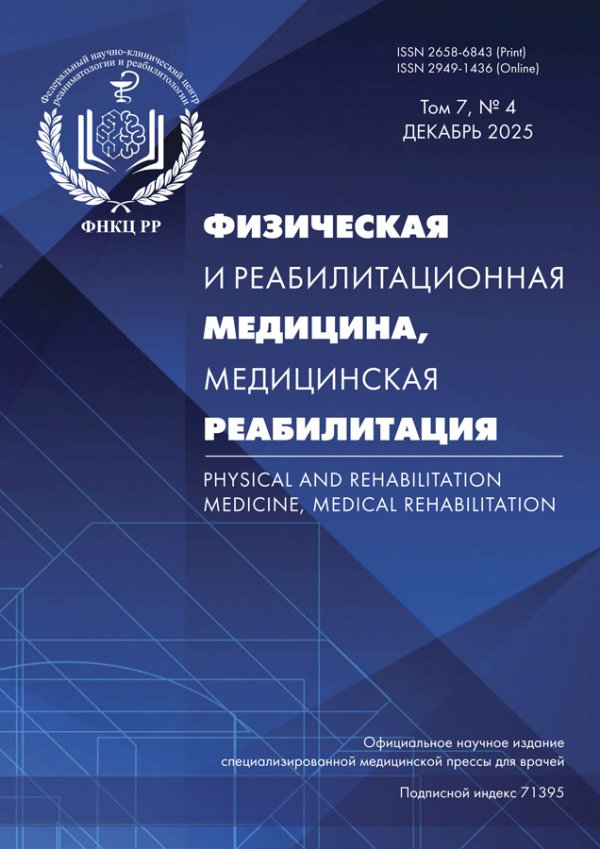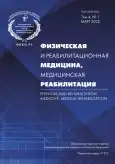Mechanisms of low-temperature rehabilitation technologies. Sports traumatic brain injury
- Authors: Shevelev O.A.1,2, Smolensky A.V.3, Petrova M.V.1,2, Yuriev M.Y.1, Zhdanova M.A.1, Mengistu E.M.4,2, Kostenkova I.Z.1
-
Affiliations:
- Federal Scientific and Clinical Center of Reanimatology and Reabilitology
- Peoples Friendship University of Russia
- Russian State University of Physical Education, Sport, Youth and Tourism
- Federal Scientific and Clinical Center of Reanimatology and Reabilitolog
- Issue: Vol 4, No 1 (2022)
- Pages: 4-13
- Section: REVIEWS
- URL: https://journals.rcsi.science/2658-6843/article/view/88833
- DOI: https://doi.org/10.36425/rehab88833
- ID: 88833
Cite item
Full Text
Abstract
According to various data, sports traumatic brain injury (TBI) accounts for up to 20% of all injuries in athletes, and the number of cases of traumatization is progressively increasing year by year due to an increase in the number of people involved in sports, the growing popularity of extreme and contact sports, as well as a high level of motivation to achieve record results. The structure of sports TBI is dominated by mild TBI, which can provoke the development of a very wide range of complications and negative consequences that affect not only the result, but, most importantly, the quality of life of athletes. The pathogenesis of mild TBI has been studied, therapy and rehabilitation programs have been developed. At the same time, the features of sports TBI that significantly distinguish it from domestic, road or criminal injuries are not sufficiently taken into account: repeated frequent TBI, increased body and brain temperature, peripheral redistribution of blood flow and hypocapnia associated with physical exertion and significantly affecting cerebral blood flow. An athlete receives a TBI during the most vulnerable period for the brain. To a large extent, these features are associated with the high incidence of various kinds of neurological complications of sports TBI (cognitive disorders, memory impairment, sleep disorders, migraines, etc.). Special techniques that can prevent complications of sports TBI have not been developed. Brain injury is an independent cause of the development of cerebral hyperthermia, which significantly worsens the course and consequences of TBI. The well-known technology of craniocerebral hypothermia (CCG) allows to reduce physical general and cerebral hyperthermia, to increase the resistance of neurons of the cerebral cortex to hypoxia and trauma. However, this technology is used sporadically, which, apparently, is due to the lack of awareness of coaches and doctors of sports teams specializing in sports medicine and rehabilitation. The purpose of the review is to analyze the features of the action of selective hypothermia of the cerebral cortex, used to prevent complications of mild sports TBI.
Full Text
##article.viewOnOriginalSite##About the authors
Oleg A. Shevelev
Federal Scientific and Clinical Center of Reanimatology and Reabilitology; Peoples Friendship University of Russia
Author for correspondence.
Email: shevelev_o@mail.ru
ORCID iD: 0000-0002-6204-1110
SPIN-code: 9845-2960
MD, Dr. Sci. (Med.), Professor
Russian Federation, Moscow; MoscowAndrey V. Smolensky
Russian State University of Physical Education, Sport, Youth and Tourism
Email: smolensky52@mail.ru
ORCID iD: 0000-0001-5663-9936
SPIN-code: 4514-3020
MD, Dr. Sci. (Med.)
Russian Federation, MoscowMarina V. Petrova
Federal Scientific and Clinical Center of Reanimatology and Reabilitology; Peoples Friendship University of Russia
Email: mpetrova@fnkcrr.ru
ORCID iD: 0000-0003-4272-0957
SPIN-code: 9132-4190
MD, Dr. Sci. (Med.)
Russian Federation, Moscow; MoscowMikhail Yu. Yuriev
Federal Scientific and Clinical Center of Reanimatology and Reabilitology
Email: myurev@fnkcrr.ru
ORCID iD: 0000-0003-0284-8913
SPIN-code: 9437-0360
MD, Cand. Sci. (Med.)
Russian Federation, MoscowMaria A. Zhdanova
Federal Scientific and Clinical Center of Reanimatology and Reabilitology
Email: mchubarova@fnkcrr.ru
ORCID iD: 0000-0001-6550-4777
SPIN-code: 4406-7802
Russian Federation, Moscow
Elias M. Mengistu
Federal Scientific and Clinical Center of Reanimatology and Reabilitolog; Peoples Friendship University of Russia
Email: drmengistu@mail.ru
ORCID iD: 0000-0002-6928-2320
SPIN-code: 1387-7508
Russian Federation, Moscow; Moscow
Inna Z. Kostenkova
Federal Scientific and Clinical Center of Reanimatology and Reabilitology
Email: kostenkovaie@mail.ru
Russian Federation, Moscow
References
- Theadom A, Mahon S, Hume P, et al. Incidence of sports-related traumatic brain injury of all severities: a systematic review. Neuroepidemiology. 2020;54(2):192–199. doi: 10.1159/000505424
- Brazinova A, Rehorcikova V, Taylor MS, et al. Epidemiology of traumatic brain injury in europe: a living systematic review. Neurotrauma. 2021;38(10):1411–1440. doi: 10.1089/neu.2015.4126
- Потапов А.А., Лихтерман Л.Б., Кравчук А.Д. Легкая черепно-мозговая травма: клинические рекомендации. Москва: Ассоциации нейрохирургов России, 2016. 23 с. [Potapov AA, Lichterman LB, Kravchuk AD. Mild traumatic brain injury: clinical recommendations. Moscow: Association of Neurosurgeons of Russia; 2016. 23 р. (In Russ).]
- Ассоциация нейрохирургов России. Сотрясение головного мозга. Клинические рекомендации (Утв. МЗ РФ, пересмотр 2021 г.). [Association of Neurosurgeons of Russia. Concussion of the brain. Clinical recommendations (Approved by the Ministry of Health of the Russian Federation, revision 2021). (In Russ).] https://ruans.org/Text/Guidelines/concussion-2021.pdf . Дата обращения: 15.12.2021.
- Угрюмов В.М. Тяжелая закрытая травма черепа и головного мозга. Ленинград: Медицина, 1974. 318 с. [Ugryumov VM. Severe closed injury of the skull and brain. Leningrad: Medicine; 1974. 318 p. (In Russ).]
- Sun YJ, Zhang ZY, Fan B, Li GY. Neuroprotection by therapeutic hypothermia. Front Neurosci. 2019;13:586. doi: 10.3389/fnins.2019.00586
- Dietrich WD, Bramlett HM. Therapeutic hypothermia and targeted temperature management for traumatic brain injury: Experimental and clinical experience. Brain Circ. 2017;3(4):186–198. doi: 10.4103/bc.bc_28_17
- Lee JH, Zhang J, Yu SP. Neuroprotective mechanisms and translational potential of therapeutic hypothermia in the treatment of ischemic stroke. Neural Regen Res. 2017;12(3):341–350. doi: 10.4103/1673-5374.202915
- Jackson TC, Kochanek PM. A new vision for therapeutic hypothermia in the era of targeted temperature management: a speculative synthesis. Ther Hypotherm Temp Manag. 2019;9(1):13–47. doi: 10.1089/ther.2019.0001
- Vaity C, Al-Subaie N, Cecconi M. Cooling techniques for targeted temperature management post-cardiac arrest. Crit Care. 2015;19(1):103. doi: 10.1186/s13054-015-0804-1
- Hine K, Hosono S, Kawabata K, et al. Nasopharynx is well-suited for core temperature measurement during hypothermia therapy. Pediatr Int. 2017;59(1):29–33. doi: 10.1111/ped.13046
- Ibragimov NK. Сraniocerebral hypothermia + nasopharyngeal cooling: effects on cerebral blood flow, intracranial pressure, cerebral perfusion pressure in patients with craniocerebral trauma. Cen Asian J Med. 2018;4:47–56.
- Gard A, Tegner Y, Bakhsheshi MF, Marklund N. Selective head-neck cooling after concussion shortens return-to-play in ice hockey players. Concussionvol. 2021; 6(2):CNC90. doi: 10.2217/cnc-2021-0002
- Шевелев О.А., Саидов Ш.Х., Петрова М.В., и др. Краниоцеребральная гипотермия как метод терапии нарушений температурного баланса головного мозга у пациентов в посткоматозном периоде // Физическая и реабилитационная медицина, медицинская реабилитация. 2020. Т. 2, № 1. С. 11–19. [Shevelev OA, Saidov SK, Petrova MV, et al. Craniocerebral hypothermia as a method of therapy of disorders of the temperature balance of the brain in patients in the postcomatous period. Physical and rehabilitation medicine, medical rehabilitation. 2020;2(1):11–19. (In Russ).] doi: 10.17816/rehab20411
- Mrozek S, Vardon F, Geeraerts T. Brain temperature: physiology and pathophysiology after brain injury. Anesthesiol Res Pract. 2012;2012:989487. doi: 10.1155/2012/989487
- Guatteo E, Chung KK, Bowala TK. Temperature sensitivity of dopaminergic neurons of the substantia nigra pars compacta: involvement of transient receptor potential channels. Neurophysiol. 2005;94(5):3069–3080. doi: 10.1152/jn.00066.2005
- Fohlmeister JF, Cohen ED, Newman EA. Mechanisms and distribution of ion channels in retinal ganglion cells: using temperature as an independent variable. Neurophysiol. 2010;103(3):1357–1374. doi: 10.1152/jn.00123.2009
- Yu Y, Hill AP, McCormick DA. Warm body temperature facilitates energy efficient cortical action potentials. PLoS Comput Biol. 2012;8(4):e1002456. doi: 10.1371/journal.pcbi.1002456
- Graig AD, Chen K, Bandy D, Reiman EM. Thermosensory activation of insular cortex. Nat Neurosci. 2000;3(2): 184–190. doi: 10.1038/72131
- Kiyatkin EA. Brain temperature homeostasis: physiological fluctuations and pathological shifts. Front Biosci. 2010;15:73–92. doi: 10.2741/3608
- Nybo L. Brain temperature and exercise performance. Exp Physiol. 2012;97(3):333–339. doi: 10.1113/expphysiol.2011.062273
- Hayward JN, Baker MA. Role of cerebral arterial blood in the regulation of brain temperature in the monkey. Am J Physiol. 1968;215(2):389–403. doi: 10.1152/ajplegacy.1968.215.2.389
- Cabanac М, Brinnel Н. Blood flow in the emissary veins of the human head during hyperthermia. Eur J Applied Physiol Occupat Physiol. 1985;54(2):172–176. doi: 10.1007/BF02335925
- Janssen FE, Van Leeuwen GM, Van Steenhoven AA. Modelling of temperature and perfusion during scalp cooling. Phys Med Biol. 2005;50(17):4065–4073. doi: 10.1088/0031-9155/50/17/010
- Ma W, Liu W, Li M. Analytical heat transfer model for targeted brain hypothermia. Int J Thermal Sci. 2016;100: 66–74. doi: 10.1016/j.ijthermalsci.2015.09.014
- Uyğun U, Küçüka S, Çolpan CO. 3B modeling and temperature distribution of human brain. 20th National Biomedical Engineering Meeting. 2016. doi: 10.1109/BIYOMUT.2016.7849378
- Веснин С.Г. Седанкин М.К. Разработка серии антенн-аппликаторов для неинвазивного измерения температуры тканей организма человека при различных патологиях // Вестник МГТУ им Н.Э. Баумана. 2012. № 11. С. 43–61. [Vesnin SG, Sedankin MK. Development of a series of antenna applicators for non-invasive measurement of the temperature of human body tissues in various pathologies. Bulletin Bauman Moscow State Tech Univer. 2012;(11):43–61. (In Russ).]
- Поляков М.В., Хоперсков А.В. Математическое моделирование пространственного распределения радиационного поля в биоткани: определение яркостной температуры для диагностики // Вестник Волгоградского гос. ун-та. 2016. № 5. С. 73–84. [Polyakov MV, Khoperskov AV. Mathematical modeling of the spatial distribution of the radiation field in biological tissue: determination of the brightness temperature for diagnostics. Herald Volgogr State Univer. 2016;(5):73–84. (In Russ).] doi: 10.15688/jvolsu1.2016.5.7
- Maloney SK, Mitchell D, Mitchell G, Fuller A. Absence of selective brain cooling in unrestrained baboons exposed to heat. Am J Physiol Regul Integr Comp Physiol. 2007;292(5):2059–2067. doi: 10.1152/ajpregu.00809.2006
- Шевелев О.А., Бутров А.В., Чебоксаров Д.В., и др. Патогенетическая роль церебральной гипертермии при поражениях головного мозга // Клиническая медицина. 2017. Т. 95, № 4. С. 302–309. [Shevelev OA, Butrov AV, Cheboksary DV, et al. Pathogenetic role of cerebral hyperthermia in brain lesions. Clin Med. 2017;95(4):302–309. (In Russ).] doi: 10.18821/0023-2149-2017-95-4-302-309
- Sharma HS. Hyperthermia induced brain oedema: Current status and future Perspectives. Indian J Med Res. 2006;123(5):629–652.
- Bain AR, Morrison SA, Ainslie PN. Cerebral oxygenation and hyperthermia. Front Physiol. 2014;5:92. doi: 10.3389/fphys.2014.00092
- Nybo L, Nielsen B. Middle cerebral artery blood flow velocity is reduced with hyperthermia during prolonged exercise in humans. Physiol. 2001;534(Pt 1):279–286. doi: 10.1111/j.1469-7793.2001.t01-1-00279.x
- Campos F, Pérez-Mato M, Agulla J, et al. Glutamate excitoxicity is the key molecular mechanism which is influenced by body temperature during the acute phase of brain stroke. PLoS ONE. 2012;7(8):e44191. doi: 10.1371/journal.pone.0044191
- Конов А.В., Шевелев О.А., Смоленский А.В., и др. Использование локальной терапевтической краниоцеребральной гипотермии для профилактики осложнений легкой черепно-мозговой травмы в спорте // Терапевт. 2015. № 11. С. 21–28. [Konov AV, Shevelev OA, Smolensky AV, et al. The use of local therapeutic craniocerebral hypothermia for the prevention of complications of mild traumatic brain injury in sports. Therapist. 2015;(11):21–28. (In Russ).]
- Шевелев О.А., Гречко А.В., Петрова М.В. Терапевтическая гипотермия. Москва, 2020. 265 с. [Shevelev OA, Grechko AV, Petrova MV. Therapeutic hypothermia. Moscow; 2020. 265 р. (In Russ).]
- Смоленский А.В., Шевелев О.А. Подходы к профилактике мягких черепно-мозговых травм в баскетболе // III Международная научно-практическая конференция «Интеграционные процессы науки и практики», 25 ноября: сборник статей. Москва, 2020. [Smolensky AV, Shevelev OA. Approaches to the prevention of mild traumatic brain injuries in basketball. Collection of articles based on the materials of the III International Scientific and Practical Conference «Integration processes of Science and practice», November 25. Moscow; 2020. (In Russ).]
- Шевелев О.А., Смоленский А.В., Тарасов А.В., и др. Температурный баланс коры головного мозга у спортсменов-боксеров во время тренировок и соревнований // Спортивно-педагогическое образование. 2020. № 4. С. 59–63. [Shevelev OA, Smolensky AV, Tarasov AV, et al. Temperature balance of the cerebral cortex in athletes boxers during training and competitions. Sports Pedagogic Education. 2020;(4):59–63 (In Russ).]
- Смоленский А.В., Шевелев О.А., Тарасов А.В., и др. Оптимизация постнагрузочного восстановления и подходы к профилактике осложнений легкой черепно-мозговой травмы в боксе // Альманах «Спорт». 2020. С. 32–34. [Smolensky AV, Shevelev OA, Tarasov AV, et al. Optimization of post-exercise recovery and approaches to the prevention of complications of mild traumatic brain injury in boxing. Almanac “Sport”. 2020. Р. 32–34. (In Russ).]
- Смоленский А.В., Шевелев О.А., Тарасов А.В., и др. Оптимизация постнагрузочного восстановления в боксе. Теория и методика ударных видов спорта спортивных единоборств // Всероссийская научно-практическая конференция с международным участием: сборник статей. Москва, 2021. [Smolensky AV, Shevelev OA, Tarasov AV, et al. Optimization of post-loading recovery in boxing. Theory and methodology of impact sports of martial arts. Collection of articles based on the materials of the «All-Russian Scientific and Practical Conference with international participation». Moscow; 2021. (In Russ).]
Supplementary files










